Zion has been served by faithful, unique, and sometimes controversial pastors during its history. During its first hundred years of existence, Zion Lutheran Church of Alva, Oklahoma, had ten full-time ministers[1][2].
Rev. Johann Ferdinand Lill – 1999-1901
Zion Lutheran – Alva was organized officially on May 21 of 1899 under the leadership of missionary Johann F. Lill[3]. Rev. Lill served as a traveling missionary at Plevna, Kansas; Nashville, Kansas; Preston, Kansas; Stafford, Kansas; and Alva, Oklahoma. On behalf of the Honorable President Hafner, Rev. J. F. Lill led the ordination and installation of Herman Meier on the 13th Sunday after Trinity in his church at Alva, Oklahoma.
Rev. Herman Meier 1901-1915
Only two years after the founding of the church, its members felt confident that they could support a full-time minister. On July 7, 1901, a call into the office of the ministry was issued to theological candidate Herman Meier. He was installed on September 9th, 1901.
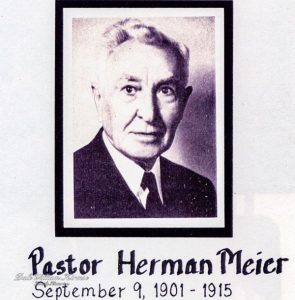
Rev. Herman Meier was born on October 29, 1877, at Crane Creek, Iowa, (near Waterloo) in an old log cabin–one of ten children. At the age of 15 he was led to begin his training for the pastoral ministry and enrolled in Concordia Seminary, Springfield, Illinois. On August 30, 1901, he married Clara Janke (less than two weeks prior to his arrival in Alva!). This was not uncommon in those days as the seminary frowned on candidates being married prior to their completion of studies for the holy ministry. They were the parents of several children while in Alva.
In addition to his duties in Alva, Meier also served preaching stations in Augusta, Waynoka, and perhaps in other small towns. He has been attributed with the organization of churches at Blackwell, Woodward, and Ponca City, Oklahoma. At the last mentioned station he became fluent in the Indian language from his association with the numerous indigenous peoples in the area. Meier moved about the Oklahoma countryside largely by way of trains, the “iron horse” as Indians called them, which connected the territory of Oklahoma. Meier’s salary started at $400 per year with a single week of vacation.
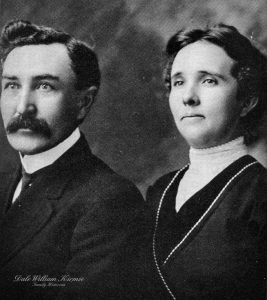
On April 10, 1904, the pastor’s salary was raised from $400 to $500 per year. In January of 1905 Emil Doman was elected to serve as church custodian for $20 a year, replacing the previous custodian, Pastor Meier, who made $12 a year.
A parochial school was opened by the fall of 1904 with.Rev. Herman Meier as the teacher with 14 students to inaugurate the school which would be an integral part of Zion’s history for over 65 years. Rev. Meier was the faculty until 1909 when the congregation employed individuals to assist him.
Meier was remembered as a “serious German,” which probably says less about the man then it does about the times. Being a ‘serious German’ just meant that you fit in. Cultivating a good sense of humor and being light-hearted is not a luxury always afforded to those whose first order of business is survival amidst plentiful adversity.
Not quite falling under the category of church discipline was the discussion conducted at the January 1, 1906, meeting in which the pastor mentioned that many people (the anonymous, but disgruntled) were bothered by the children who sat together during worship and seemed restless which is, as Pastor Meier said, “obviously a contempt for the Word of God.” A spirit of dissatisfaction then must have come over the meeting because the pastor went on to express his disappointment with the congregation’s weak and dispirited chanting in worship and the pathetically inadequate quality of their `amens.’ Amen’ means we confirm this prayer, the pastor explained, and it warrants more enthusiasm than he was detecting.
During the Christmas holidays of 1914 Rev. Meier preached his farewell sermon, having accepted a call to Lockport, New York, where he remained for a remarkable 39 years. He finally retired from the ministry in 1954. He returned to Zion to participate in the celebration of our 50th anniversary in 1949.
After the death of his wife Klara he frequently visited Alva spending several days with old acquaintances and members of the church. From here he would go to Roswell, N.M. and Amarillo, Texas, to visit with two of his daughters living there. His last visit to Alva was in the 1960s. Rev. Herman Meier was born to eternal life on January 27th, 1964, at the age of 87.
Rev. M.K.C. Vetter 1915-1922
In 1915 Zion called Pastor M.K.C. Vetter of Junction City, Kansas. He accepted the call and was installed on Jan. 10, 1915–surprisingly only a few weeks after Rev. Meier’s departure. Whereas Meier had been a young candidate out of seminary, Vetter was already a more mature man. Vetter was born in 1871 and married to his wife Mina in 1898 (She lived to be 104 years old!) To this union came the blessing of seven children. The girls were particularly well remembered for their striking physical appearance which drew the attention of many a young man in the congregation.
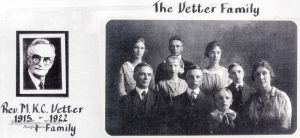
In 1999, only a few of our older members will remembered Pastor Vetter. It was he who confirmed the 97-year-old Christine Honer (though she was even taught by and remembered Pastor Meier as well). Ms. Honer, along with Norman Schaefer remembered Rev. Vetter as a very serious, straight-laced man. He departed from Alva in December of 1922 when he received and accepted a call to be a superintendent. of a Lutheran orphanage near the Chicago area. He continued to have a long and distinguished career at the orphanage. The much beloved couple came to be known as “Ma” and “Pa” Vetter. Pastor Vetter, like his wife, enjoyed a long life, being received into the Church Triumphant on January 23, 1961.
Rev. Walter Meyer 1923-1927
Once again the search was on for a minister. After several pastors declined to come to Alva, the congregation extended a call to Walter H. Meyer by the decision of the voters made on April 15, 1923. He accepted and was install( on May 6 of the same year.
Meyer’s service at Zion of Alva was unconventional for the fact that he was a native son of the area and the congregation. Born in 1894, Meyer graduated from St. John’s College in Winfield, Kansas, in 1914 and then Concordia Seminary, St. Louis in 1918. Two months following his graduation from the seminary (a pattern we noted in conjunction with Pastor Meier) he married Anna Koppitz. He served his first call in Optimo, New Mexico, and then Grandfield, Oklahoma before returning home in 1923.
By odd coincidence, he arrived to find that amongst the members of this congregation was the E.G. Kletke family, which had moved to Optimo, New Mexico to spell the tuberculosis of E.G.’s wife and had returned to Alva.
Meyer and his wife had four children, one of whom died at the age of six. Two of his sons went on to become ministers like their father. Their daughter became a Lutheran school teacher. After taking a call and departing Zion on October 9, 1927, he went on to serve the Kansas district as a pastor in Haven and Independence as well as serving for 21 years as the Kansas District President.
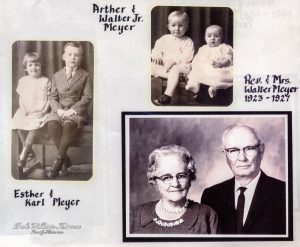
Meyer would later return to serve in Alva during a vacancy period.
Above all else Meyer was recalled as a remarkably kind and gentle man. Norman Schaefer, recalled that Meyer was a tremendous baseball player, pitching for the “Frog-Hollers” which was made up of more than few Lutherans, one of which was Mr. Schaefer’s father. The legend of the Frog-Hollers remains in Alva. They were loaded with talent. One uncle of member Verlin Weibener pursued a professional career and had a try out in the major leagues. Pastor Meyer was himself a great pitcher, who at one time also considered a career path in baseball. When opposing teams found out that Meyer was to pitch on a given day, they reportedly, figured there was little sense in showing up as they were not likely to beat Meyer. The home games were played out on a prairie field now farmed by member, Ella Brehmer.
Rev. Otto Henry Hoyer 1927-1954
In a meeting held on October 16, 1927, (note the astonishing brevity of vacancy periods in those days) the congregation called Pastor Otto Hoyer, who accepted and was installed on November 27, 1927. The recollections of Rev. Otto Hoyer are legion as he was privileged to serve in Alva until 1953. During his pastorate the stock market crashed, the Great Depression came and went, and World War II was fought, as well as the Korean conflict.
Otto Hoyer was born in Kansas on September 4, 1890. He followed in his father’s footsteps and entered the ministry in 1914 after graduating from Concordia Seminary, St. Louis. He served a three-point pastorate in Nebraska before being forced to resign in 1926 due to a surgery he had undergone. By 1927, however, he was able to accept the call extended by Zion of Alva. Hoyer and his wife, Frieda, had 8 children born to their union. Hoyer was, by consensus opinion, a pious and sober man. He was always immaculately dressed and smoked cigarettes incessantly, a point of embarrassment to some of the members who were concerned over the image this presented. However, some have spoken about his fun loving side which especially surfaced in his interactions with the Young People’s Society.
Hoyer pastored the Church through the hard days of the Depression and Dust Bowl. It is a remarkable fact that, for most non-Oklahomans who did not live through this period, most of our conceptions of what the dust-bowl of this area meant is largely shaped by works of fiction, such as The Grapes of Wrath, and Woody Guthrie folksongs. No one doubts that families like the Joads existed who were “tractored” off the land, but there were also a lot of families named Rauh, Ritter, Dubben, Lohmann, and Kirmse who dug in their heels and were able to ride out the storm by the strength of their faith in God. In 1932, Rev. Hoyer, dependant upon contributions from struggling farmers, took, along with the teacher, a 20% cut in salary. Strangely, the next item in the voters’ assembly minutes for that day approved the building of the parish hall. Of course, all the labor was by way of volunteers, but the two items look odd standing one beside the other. In 1937 their salaries were again raised. One interesting item is to be found in the minutes during 1937 regarding a collection taken up for flood victims. What flood that is pertaining to is not mentioned.
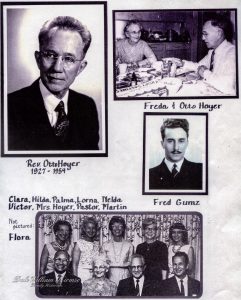
Even during Pastor Hoyer’s long service there were periods of personal difficulty. On January 28, 1940, a motion was made and carried to empower Vicar Gumz to administer the sacraments and serve the congregation in every capacity as its pastor, save the power to perform marriages. Rev. Hoyer had taken sick that year which prompted this decision. It is anyone’s guess if this illness was related to his surgery of 1926 and subsequent time off. It is an amazing testimony either to the discretion of the people at that time, or of Hoyer himself, that no one presently seems to know what it was that hindered Hoyer during that year.
On October 6, 1946, a pipe organ was dedicated at Zion with an evening concert. This replaced the old pump organ which the church had been using. Pastor Hoyer was quite adept and served not only this church but many other churches and private citizens in the repairing and maintenance of pump organs.
Pastor Hoyer also served as the President of the Oklahoma District (1943-1954) during his stay in Alva. Due to declining health, on March 21,1954, Pastor Hoyer asked for peaceful release from the congregation that he might serve a smaller parish in Blackwell which would not require such an expenditure of strength. It was granted and he departed after over 26 years of faithful service effective June 1,1954,
One of the best-loved and well-remembered stories about Pastor Hoyer was the occasion on which his own son, Victor, along with some other boys, was misbehaving in the balcony during the sermon. His father, the reverend, stopped cold in the middle of the sermon, pointed his finger up into the balcony and told his son to remove himself from that balcony and locate his posterior on the front pew. The service stayed on hold until the younger Hoyer came down the stairs, walked the length of the church and found his seat. This was not the only time, by any means, in which he halted the sermon to call restless youngsters back into line. Reverend Otto Hoyer was the prototypical German Lutheran pastor of his era.
Rev. Earl Krupp 1954-1963
The congregation now faced a situation which had been wholly foreign to them for nearly 30 years – a vacancy. Nonetheless they went about the business of finding a new pastor. Though there were adjustments to be made, it was the consensus of many that this day was known to be coming and that it was indeed time for this change. The first two calls extended were returned but the third, made to Earl Krupp, was accepted. Reportedly only one vote was cast against Krupp due to the fact that he was not well-versed in the German language. He arrived and was installed in August of 1954.
Pastor Krupp was a young, vibrant man. The congregation was familiar with him as he had served his vicarage here under the tutelage of Pastor Hoyer in 1942. During his vicarage stay Krupp had endeared himself to many by showing his willingness to work and understand the natives. He was employed by Henry Lohmann during harvest as well as at other times. Krupp was originally raised in Brooklyn, New York, as a Roman Catholic. So he went through two conversion experiences: one from Catholicism to Lutheranism and another from being a city-slicker to a country-boy. Rev. Krupp remains a highly respected and dearly loved figure by this congregation. His personality was engaging he had a lively sense of humor and a pleasant family.
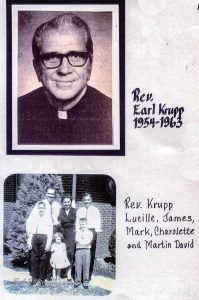
After a 27-year-pastorate under Rev. Hoyer, Pastor Earl Krupp was a near 180 degree turn, which is not to place higher regard on either pastor, but their styles of ministry were different. Krupp brought in innovations which are easily rehearsed by the recollections of members. It was he who initiated the Easter Sunrise Services in 1955 at the drive-in theater[3]. Families assembled at the drive-in, often times still in pajamas, bathrobes and curlers to listen to a message delivered from the back of a flat-bed pick-up. In that same year the congregation held the first Vacation Bible School. An organization comprised of young couples and singles which grew to be quite active also began that year known as the Merry Mates. Krupp began the practice of holding a Church Council meeting prior to the regular voters’ assembly meetings. And during the voters’ assembly of October 3, 1954, it was resolved to discontinue the printing of individual yearly contributions. Previous to this decision it was a matter of public knowledge, through the media of print, what each family or person gave to the church.
Other changes were also taking place in the church at this time apart from Pastor Krupp’s influence. It was recognized already toward the end of Pastor Hoyer’s pastorate that the time for a new parsonage was at hand. After much discussion and study, building a new parsonage, just north of the church, was proposed and approved in 1954,
Special recollections of Pastor Krupp include Another member remembers that there was a short in the microphone on the pulpit which which would pop when it was tapped on. Reportedly, Krupp would sometimes rouse the congregation during the sermon, if he detected some inattentiveness, by giving the microphone a good snap.
Rev. Earl Krupp accepted a call in 1963, to Redeemer Lutheran Church in Enid. Pastor Krupp resides today in Spokane, Washington.
Rev. Herman Baumann 1964-1968
In 1964 the congregation offered two calls for a new pastor before the third was finally accepted by Hermann Baumann. The first call was extended to Glen Kollmeyer, like Krupp a former vicar of the congregation. He declined but would later serve as a vacancy pastor in the 80s. The second was Rev. Klawitter who also declined. On August 30 Rev. Hermann Baumann became the pastor of Zion.
Pastor Baumann had the distinction of serving this congregation during one of the most tumultuous times in both our nation and our church. During the 60s the Walther League, formerly a vibrant youth organization, fell into controversy and fell apart; the school which had long been an important part of the church’s life and ministry closed its doors; and an awareness of the possibility that the old church could no longer sufficiently serve the needs of the congregation continued to grow. Even as the school was preparing to end and finally did close their doors, a long range building committee was meeting. This, we believe, to be a remarkable testament to the hopeful spirit of the people of Zion. Whereas they could have seen the closing of the school as a forecast of decline, they saw it instead as a step in the life-cycle of the church which did not necessitate the rolling over and dying of a congregation. They were still looking to the future.
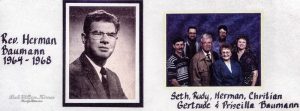
Another difficulty during this period precipitates from the fact that there was a larger battle taking place within our culture between the generations. Undoubtedly, that tension had to be reflected in the fact that Hermann Baumann was more a throw-back to the older style of German, Lutheran pastors. Perhaps had he followed Rev. Hoyer directly the change would have been a smooth one, but Pastor Krupp had brought with his ministry a feeling of youth and vitality. Following a popular pastor is always difficult, but to bounce back to where they had been before felt too much like a regression for the congregation. On February 11, 1968, Rev. Hermann Baumann officiated his last service at Zion making his the shortest pastorate at this church to date.
In March of 1968, the congregation reverted to one service on Sunday instead of two, which had been initiated near the beginning of Rev. Krupp’s ministry. Pastor Baumann, born in 1926 in Alabama, came to Zion after 8 years in Texas where he established several churches. He and his wife were blessed with three children. Though leaving the ministry for a time, he later resumed the work and currently resides in Alabama.
Rev. Arnold J. Brase 1969-1974
Pastor Walter Meyer returned, after a long and faithful ministry in the Kansas district, to serve during the vacancy which occurred after Rev. Baumann’s departure. The place was, however, soon filled by a Pastor Arnold J. Brase.
Reverend Brase’s pastorate was most notably characterized by its chief undertaking of guiding the congregation through the construction of a new church. As It seems as though the completion of this transitional period for Zion–the construction of a new building–marked what Pastor Brase saw as a completion of his time of service. He had seen finished what needed to be done and it was time to move on.
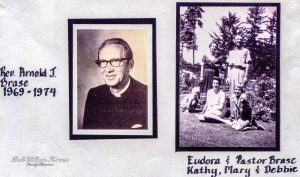
One of the curiosities about A.J. Brase is that he was known to jog around the football track at ‘ the high-school. Not a particularly odd sight nowadays, back then when someone went running people either stopped to offer them a ride or else tried to see what it was they were running from. Mrs. Brase was very active in church, teaching Sunday School and organizing parishioners to make intentional trips to the hospital to visit the sick.
Pastor Brase was a native Oklahoman, born in Logan County in 1908. He attended Oklahoma State University for one year before entering the Springfield Seminary from which he graduated in 1935. His first call was as a teacher in Hooker, and to serve the congregations in Boise City and Texhoma. He also served in Woodward, Perry, and Roswell, New Mexico.
Rev. Paul Hoppe 1975-1986
Pastor Paul Hoppe followed after Rev. Brase and remained at the congregation until 1985. He was a quiet and gentle man, and well-respected. Born on September 17, 1946, in Sheboygan, Wisconsin, Hoppe went on to complete his education for the ministry at Concordia Seminary, St. Louis in 1972. Previous to Zion, he served for a short time in Parsons, Kansas. It was during his stay that the congregation made several endeavors with an additional staff position as a Director of Christian Education.
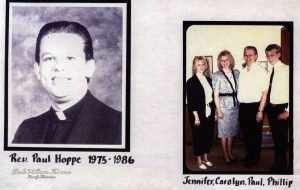
One of these DCEs, Velmer Goebel, elected in 1980 to enter seminary and prepare for the pastoral ministry. He received his first call to Medicine Lodge, Kansas, in 1984, and then to nearby Lahoma, from which he served Zion during parts of 1996 and 1997 as a vacancy pastor. The need for a viable youth ministry continued to be a challenge facing the congregation especially after the dissolution of the Walther League in the late 1960s.
Another event of significant proportions was the celebration of the church’s 80th anniversary on November 4, 1979, along with the burning of the debt for the new church just five years after it was built! During the service the congregation reminisced by, among other things, employing Klingen Beutel (red velvet bags attached to long sticks to take the offering).
Rev. Glenn Kollmeyer 1986-1988
When Rev. Hoppe left in 1985, the time of vacancy was filled by retired Pastor Glenn Kollmeyer. Anyone who has had the privilege of meeting him knows that a kinder, gentler man can hardly be imagined.
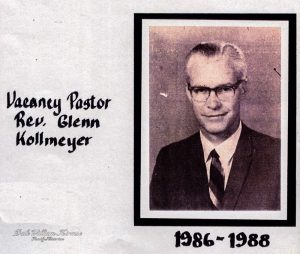
Rev. Kollmeyer was long known to the congregation. Called once before to fill this office he had declined at that time. Kollmeyer, years before, had been a vicar under the venerable Pastor Hoyer, much beloved then as well.
Rev. Mark Neumann 1988-1996
In 1988 Pastor Mark Neumann arrived in Alva where he would serve until 1996. It becomes more and more difficult to assess those things which were most significant at Zion as we draw closer to the present day. Perspective of some years will be needed perhaps.
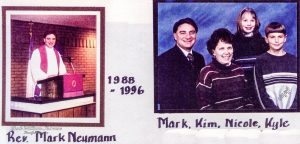
During Pastor Neumann’s stay the educational wing was built. As with any building project, money was a major concern. Much was saved as the resourceful members of this congregation pooled their energies and abilities to do much of the labor themselves. The results exceeded saved dollars as the time-intensive work brought many in the church together with an opportunity to grow in fellowship. We’ll know in ten years if they did too much talking to pay good attention to their work or not, depending on whether it’s still standing. In truth, the addition is beautiful and the envy of many churches in town.
Also during this time, the school building, which had served only as Sunday School classrooms since 1968, became the Lutheran Day Care/Preschool and continues to successfully serve this community in that capacity.
One unpleasant memory for many members of this congregation will be of Easter weekend, 1995, when a group of vandals overturned 35 headstones and crushed several vases at the Lutheran Cemetery. Damage from the incident totalled $17,000, but fortunately repairs were done for free by a local businessman until they were paid off by fines to the parents of the youths, who were caught in August of the same year.
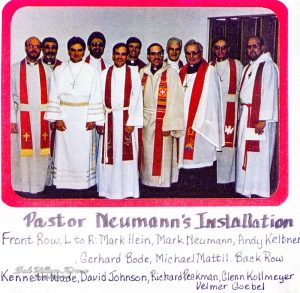
In 1996 Pastor Neumann, the legendary fisherman from the north, returned to that direction, taking a call to a community outside of Detroit, Michigan. Rev. Neumann was installed on January 10, 1988, after serving previously to that in Land O’Lakes, Wisconsin, from 1984-88. He met his future wife, Kim, while attending school at St. Paul’s College High in Concordia, Missouri. He studied also at Concordia College, Seward and at Concordia Seminary, St. Louis. The Neumanns were blessed with two children, Nicole born in 1985 and Kyle in 1988.
Rev. Goebel of Lahoma, by this time the Enid Circuit counselor, served Zion. For the first time in her history, Zion was forced to drastically alter its pattern of worship due to the distance Pastor Goebel had to cover in serving two churches. Sunday evening church, the only viable solution, hurt worship attendance and called for strong lay leadership within the church.
Rev. Joel T. Picard 1997-
At the 100 Year Anniversary, the congregation was served by Rev. Joel Picard. Ordained on August 17, 1997 (two weeks after having been married to Stacy DeBoef), with District President William Diekelmann presiding, Pastor Picard has been the first pastor to come directly from school to Alva since the Rev. Herman Meier in 1901. Rev. Picard and his wife Stacy were blessed with their first child, Hannah, in the summer of 1998.
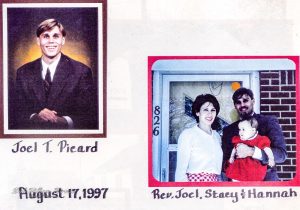
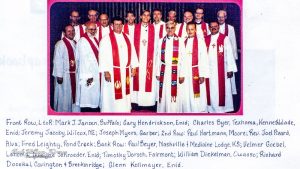
Though undoubtedly a difficult time for the congregation, it seems already apparent that the greater self-sufficiency it prompted has served this people well. In the last days of 1998, as we pen these lines, Zion has the appearance of a vibrant congregation, growing in confidence and stature in this community which has, for so long, been its home. Just this month, the enormous financial debt incurred through the building of the education wing has been paid off. Worship attendance is healthy. God has richly blessed these people for the last 100 years. It is our prayer that we cherish dearly our past, but also that we imitate our predecessors by gazing toward tomorrow and asking how this church could in the future remain faithful and devout in its mission to proclaim Jesus Christ to the ends of the earth.
Notes
- Zion Lutheran Church – Alva, Oklahoma 100 year celebration booklet “Zion Lutheran Church 1899-1999 Alva, OK”. 1999.
- Having only ten pastors in 100 years is an especially telling figure when one considers that the average stay for a Lutheran Church – Missouri Synod pastor today is measured in months and not years (less than 3 years), and that this average exceeds that of other protestant denominations.
- Julius Kirmse, my father, was the person initially responsible for the set up at the drive-in for the Easter sunrise service. He designed and had fabricated a large purple cloth cross to hang in front of the theater screen. I remember that he took great pains to make sure to design the cross so that it would release the wind through slots in the cloth and not flap against and damage the theater screen. On the Saturday afternoon before Easter Sunday we tested and practiced getting all the ropes and pulleys in place. Then the whole assembly was taken down so the theater could have a Saturday night showing. Very early Easter Sunday morning, dad’s pickup truck with a flat-bed was driven in front of the screen and we quickly hauled up the cross. In the morning breeze the cross did not flap against the screen but bellowed out – it was beautiful.
